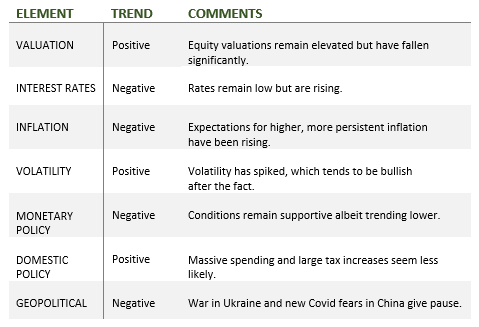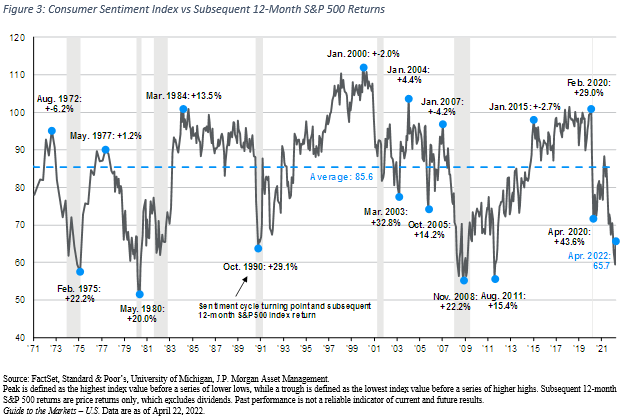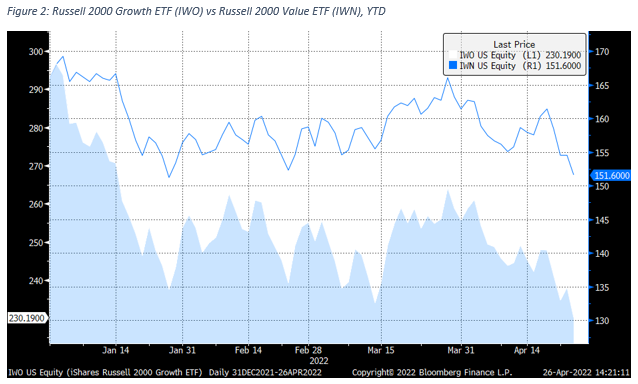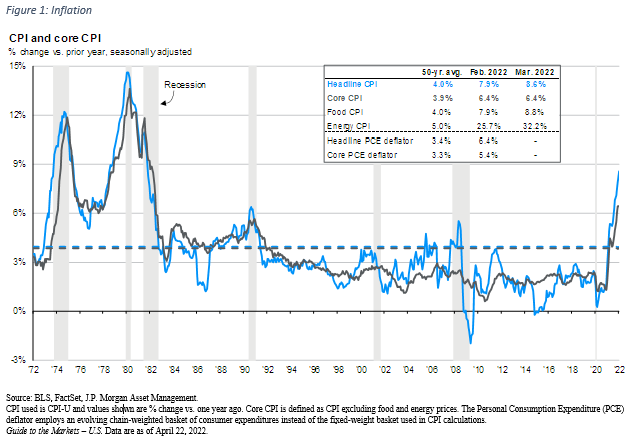
There’s Lots of Bad News. That’s Good News.
After seven consecutive quarters of positive returns, the S&P 500 finally turned in a clunker in the first quarter of 2022, posting a negative total return of 4.6 percent. The other major domestic indices were negative also, with the Dow Jones down 4.1 percent, and the tech-oriented NASDAQ down 8.9 percent on a total return basis.
There was no shortage of gloom and doom on which to blame the market’s downturn. From the first week of the year, just as the Omicron variant was entering a hopefully final blow-off stage, markets turned their collective concern away from COVID-19 and onto inflation, the byproduct of massive fiscal and monetary stimulus, supply chain disruptions, and a post-pandemic hiring bonanza. While a certain amount of inflation was to be expected, these historically large year-over-year price increases have proven stickier than many economists predicted. Then of course, the coup de grace was the horrific Russian invasion of Ukraine, which served to not only exacerbate surging energy prices but to cast a pall over global growth projections as well. Rising inflation was already poised to erode strong annual real economic gains—but war in Ukraine threatens to dampen those gains further and cause the economy to teeter into a recession next year.
The U.S Treasury yield curve, a generally reliable predictor of future recessions, went negative on the first day of the second quarter and financial markets took notice, with broad market indices continuing their decline. While the move was brief and the curve has since steepened again, rising interest rates have had a severe impact on financial markets this year, especially on the more speculative areas.
Markets are now pricing in 50-basis-point interest rate increases at each of the next three Fed meetings, expectations that in January would have seemed completely fantastical. During the teeth of the Covid lockdown, the Federal Reserve abandoned its primary mandate of price stability in favor of promoting maximum employment, indicating it would allow inflation to “run a little hot.” Well, it would appear the Fed achieved that objective, with the U.S. unemployment rate at 3.5 percent, a level last seen in 1969, and the highest headline inflation since 1981. Now the Fed finds itself in the unenviable position of having to quash inflation without choking off the U.S. economy, and there is increasing momentum behind a plan to “front-end load” the interest rate increases it will use to tighten monetary conditions. There’s little doubt the Fed will eventually douse the flames of inflation, but the prices of financial assets will react in perhaps some unpleasant ways in the near term, especially in the more speculative areas of the market.

Rising interest rates tend to make for volatile markets, and these rate increases have differing effects on different assets. Broadly speaking, the rising price of money has the greatest impact on assets with the longest duration—assets that require the longest “payback” period, often called “long duration” assets, see their prices change the most when rates are changing. Examples of these assets are long -dated bonds and expensive growth stocks—stocks that investors have bid up in hopes of a substantial payback in the distant future. The problem is that when rates are at rock-bottom, it’s a lot easier to make the case to wait years to get paid back than it is when rates are shooting up and investors can earn money elsewhere instead of waiting.
This is being borne out in real time in markets right now. During the first quarter, as rates were rising, the Russell 2000 Value Index lost about 2.5 percent while the Russell 2000 Growth Index fell 12.7 percent. So far in April, the trend has continued, with value outperforming growth by about 1300 basis points for the year at the time of this writing. Some of the best performing stocks over the last several years have been caught in brutal sell-offs, with names such as Facebook (now known as Meta) and Netflix down 46 percent and 67 percent, respectively.

Value strongholds such as energy and materials have not been completely immune either. With recent reports of new Covid lockdowns in China and lower global growth expectations, these sectors have tumbled also.
Rising interest rates and inflation also tend to have an outsized impact on small cap stocks. Intuitively, this makes sense, with smaller companies more likely to feel the impact of these factors in the real world, but there’s also the reality that as interest rates rise and liquidity recedes from financial markets, small cap stocks react more negatively, just as they react more positively when liquidity increases at the margin.
Market volatility has spiked, which is unsettling, but it’s also worth maintaining a little perspective. The S&P 500 is now down about 10 percent for the year on a total return basis. Going back to 1980, the market averages a 14 percent intra-year drawdown every year, despite an average annual return of 9.4 percent and positive returns for more than 75 percent of those years. What the broad market is experiencing may seem extreme, but it’s only extreme in comparison to extremely recent experience. It’s also worth pointing out that for the two years ending with the first quarter, the S&P 500 returned more than 89 percent. The Dow Jones returned almost 75 percent and the NASDAQ almost doubled.
So while the bears are having their day, our contrarian impulses are quickening a little. Market volatility is well-above long-term averages, which suggests better times might not be too far ahead. Lastly, consumer confidence is as low as it has been in more than a decade, understandably driven down by stubbornly high inflation. This, counterintuitively, is also good news, as such dismal expectations are often followed by powerful rallies.

While we are not managing client portfolios by trading in and out of every market spike or downturn, you can be assured we continue to monitor markets with a gimlet eye. Moreover, while we are not attempting to predict the future, we can confidently say that equity portfolios are performing as we might expect in this environment, with our value tilt providing a significant tailwind to performance along with our international tilt while our small-cap tilt is a headwind. In a nutshell, diversification is paying dividends, as it does over the long term.
We thank you for you continued trust in our stewardship.
Burke Koonce